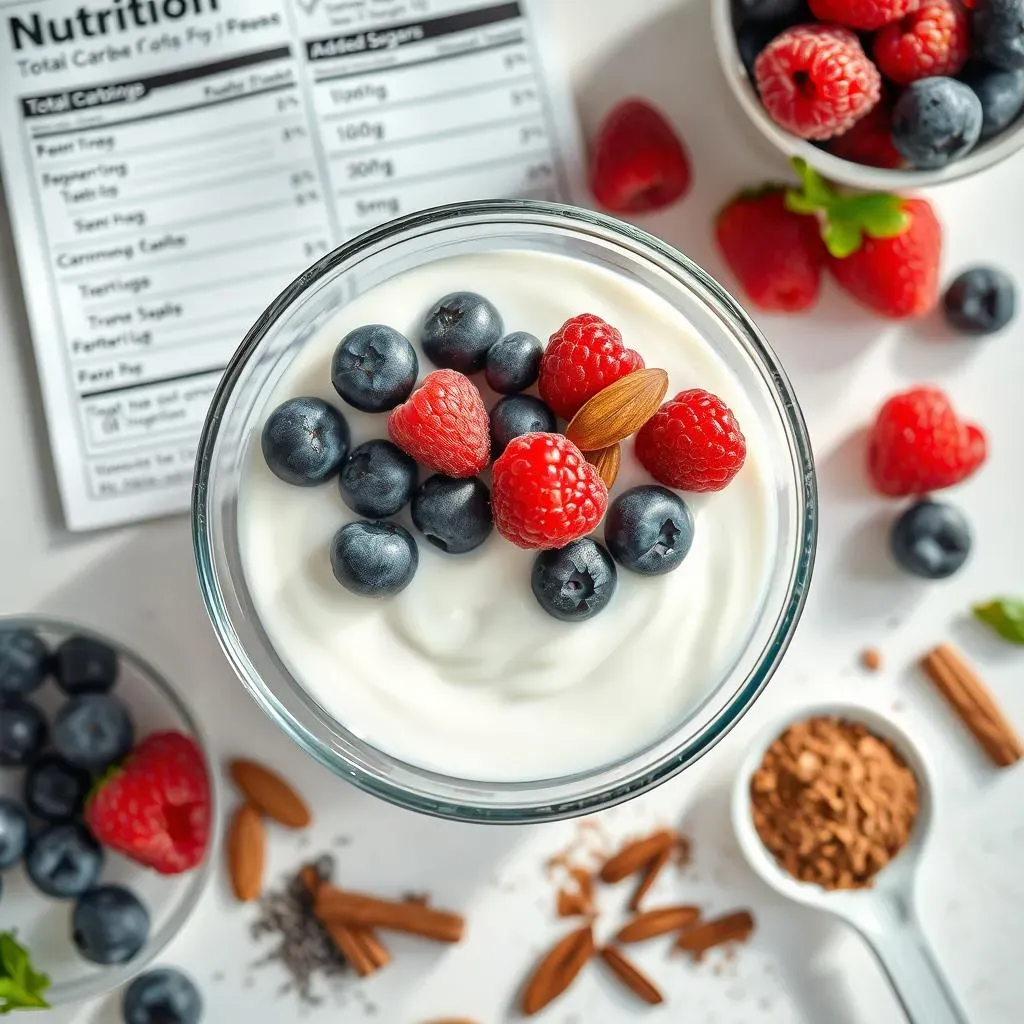Table of Contents
Navigating the world of healthy eating can feel like a maze, especially when you're trying to keep an eye on your carb intake. Yogurt, a breakfast and snack staple, often comes under scrutiny. If you're wondering, "how many carbs in low fat yogurt?", you're not alone. This seemingly simple question opens up a can of worms, as the carb content can vary wildly depending on the type, brand, and added ingredients. From plain to flavored, Greek to regular, the carbohydrate landscape of low fat yogurt is diverse and sometimes confusing. This article will break down the carb counts in various low fat yogurt options, explain what factors influence these numbers, and equip you with the knowledge to make informed choices that align with your dietary goals. Whether you're following a low-carb diet, managing diabetes, or simply curious, we'll guide you through the ins and outs of yogurt carbs, ensuring you can enjoy this nutritious treat without the guesswork.
Understanding the Carb Content of Low Fat Yogurt

Understanding the Carb Content of Low Fat Yogurt
so you're diving into the carb situation in low fat yogurt? Awesome! First things first, let's get one thing straight: not all yogurts are created equal when it comes to carbs. The base carb content primarily comes from lactose, which is the natural sugar found in milk. During the yogurt-making process, some of this lactose is converted into lactic acid, which is why yogurt has that tangy flavor. However, the amount of lactose that remains directly impacts the carb count. Also, some brands add extra sugar or sweeteners.
Now, a 6-ounce (170g) serving of plain, low fat yogurt typically contains around 8-12 grams of carbohydrates. But before you grab just any container off the shelf, remember that this is just an average. Flavored yogurts? They're a whole different ballgame. Manufacturers often pump them full of added sugars to enhance the taste, which skyrockets the carb content. We're talking potentially doubling or even tripling the carb count compared to plain varieties. So, always, always check the nutrition label. Seriously, it's your best friend in this carb-counting adventure.
To give you a clearer picture, here’s a little breakdown:
Type of Low Fat Yogurt | Approximate Carb Count (per 6-ounce serving) |
|---|---|
Plain, Unsweetened | 8-12 grams |
Lightly Sweetened | 12-18 grams |
Flavored (Fruit, Vanilla, etc.) | 18-30+ grams |
See the difference? It's pretty significant. So, if you're serious about keeping those carbs in check, plain, unsweetened low fat yogurt is definitely the way to go. You can always add your own healthy toppings like berries or a sprinkle of nuts for flavor without the added sugar overload.
Low Fat Yogurt Varieties: Carb Counts Compared

Low Fat Yogurt Varieties: Carb Counts Compared
Alright, let's dive into the nitty-gritty of different low fat yogurt varieties and their carb counts. It's not enough to just grab anything labeled "low fat;" you've got to be a savvy shopper. We're talking about Greek yogurt, regular yogurt, flavored options, and even some dairy-free contenders. Each has its own carb story to tell.
First up, Greek yogurt. This stuff is a rockstar in the yogurt world, especially if you're watching your carbs. Because of the straining process it undergoes, Greek yogurt has less lactose (and therefore fewer carbs) compared to regular yogurt. A 6-ounce serving of plain, low fat Greek yogurt typically clocks in around 5-8 grams of carbs. Not bad, right? Regular low fat yogurt, on the other hand, usually sits in the 8-12 gram range for the same serving size. So, Greek yogurt already has a slight edge.
But wait, there's more! Flavored low fat yogurts are where things get tricky. These can be loaded with added sugars, syrups, and fruit preparations that send the carb count soaring. We're talking upwards of 20, 25, or even 30+ grams of carbs per serving. Always scope out the nutrition label before you commit. And don't be fooled by labels like "light" or "diet." They might be lower in fat or calories, but they can still be high in carbs due to added sweeteners.
And what about dairy-free options? Coconut yogurt, almond yogurt, soy yogurt – they're all vying for a spot in your fridge. The carb content here varies wildly depending on the brand and ingredients. Some are naturally lower in carbs, while others are packed with added sugars to mimic the taste and texture of traditional dairy yogurt. Again, reading the nutrition label is your golden ticket.
Here’s a quick rundown to keep things clear:
Type of Low Fat Yogurt | Approximate Carb Count (per 6-ounce serving) |
|---|---|
Plain, Low Fat Greek Yogurt | 5-8 grams |
Plain, Low Fat Regular Yogurt | 8-12 grams |
Flavored Low Fat Yogurt (Dairy & Non-Dairy) | 18-30+ grams |
Dairy-Free (Almond, Coconut, Soy) | Varies widely, check label |
So, the takeaway here is to be a label detective. Don't let those sneaky added sugars sabotage your carb-conscious efforts. Opt for plain, unsweetened varieties whenever possible, and jazz them up with your own low-carb toppings. Your taste buds (and your waistline) will thank you!
Factors Influencing Carb Counts in Low Fat Yogurt

Factors Influencing Carb Counts in Low Fat Yogurt
Lactose Levels and Yogurt Production
So, you're digging into what messes with the carb count in low fat yogurt? Let's start with the basics: lactose. Lactose is that natural sugar in milk, and it's the primary source of carbs in plain yogurt. Now, here's where it gets interesting. During yogurt production, bacteria munch on some of the lactose, turning it into lactic acid. This is what gives yogurt its signature tangy taste. The longer the fermentation process, the more lactose gets converted, potentially lowering the carb count. However, not all yogurt is fermented for the same amount of time, which means the amount of residual lactose can vary.
Also, different strains of bacteria have different appetites for lactose. Some strains are more efficient at converting lactose into lactic acid than others. So, the specific bacterial cultures used in a particular brand of yogurt can also influence the final carb content. It's a bacterial buffet in there, and what they eat (or don't eat) directly affects how many carbs end up in your bowl. Isn't science delicious?
Added Sugars and Sweeteners
let's talk about the elephant in the room: added sugars. This is where things can go sideways real fast when it comes to carb counts in low fat yogurt. Manufacturers often sneak in extra sugars, syrups, or fruit preparations to make their yogurts more appealing to the masses. I mean, who doesn't love a little sweetness, right? But these added ingredients can drastically increase the carb content, often without you even realizing it. Even "natural" sweeteners like honey or maple syrup contribute to the total carb count.
And don't be fooled by the "low fat" label. Sometimes, to compensate for the lack of fat, manufacturers add even more sugar to improve the taste and texture. It's a sneaky trick, and it's why you've got to be a vigilant label reader. Look beyond the big numbers on the front of the container and dive into the ingredient list and nutrition facts panel. Pay close attention to the "added sugars" line, as this will give you a clear picture of how much extra sweetness has been stirred in. Remember, knowledge is power, especially when it comes to navigating the treacherous waters of yogurt carbs.
Type of Sweetener | Impact on Carb Count |
|---|---|
Added Sugars (Sucrose, High Fructose Corn Syrup) | Significant increase |
Natural Sweeteners (Honey, Maple Syrup) | Increase, but may offer some nutrients |
Artificial Sweeteners (Aspartame, Sucralose) | Minimal to no impact |
Sugar Alcohols (Erythritol, Xylitol) | May have a lower impact, but can cause digestive issues |
Smart Choices: Picking the Right Low Fat Yogurt for Your Carb Goals

Smart Choices: Picking the Right Low Fat Yogurt for Your Carb Goals
Read the Labels Like a Pro
so you're serious about making smart choices with low fat yogurt and keeping those carbs in check? Then you've got to become a label-reading ninja. Seriously, this is non-negotiable. Don't just glance at the big numbers on the front of the container and assume you know what's up. Dive into the nutrition facts panel and the ingredient list. Pay close attention to serving size, total carbohydrates, added sugars, and the presence of any sneaky sweeteners. Remember, manufacturers can be pretty clever with their marketing tactics, so it's up to you to be an informed consumer.
Look for yogurts with minimal added sugars – ideally, zero. The total carb count should be in line with your overall dietary goals. And don't forget to check the ingredient list for any hidden sources of carbs, like fruit purees, syrups, or starches. The fewer ingredients, the better. A clean label is usually a good sign that you're making a healthier choice. And hey, if you're not sure about something, do a quick Google search or consult with a registered dietitian. Knowledge is your superpower in this carb-conscious quest!
Opt for Plain and Customize
Alright, here's a pro tip that will change your yogurt game forever: opt for plain, unsweetened low fat yogurt and customize it yourself. Seriously, this is the way to go if you want to have full control over your carb intake and avoid those sneaky added sugars. Plain yogurt is like a blank canvas – you can add whatever flavors and toppings your heart desires, without the guilt. Think fresh berries, a sprinkle of nuts or seeds, a dash of cinnamon, or even a little bit of unsweetened cocoa powder. The possibilities are endless!
By customizing your yogurt, you can not only keep the carb count in check but also boost the nutritional value. Berries are packed with antioxidants and fiber, nuts and seeds provide healthy fats and protein, and cinnamon adds a warm, comforting flavor without any added sugar. So, ditch the pre-flavored yogurts and unleash your inner chef. Your taste buds (and your waistline) will thank you for it. Plus, it's a fun way to get creative in the kitchen and experiment with different flavor combinations. Who knows, you might just discover your new favorite yogurt creation!
Topping | Approximate Carb Count (per serving) | Benefits |
|---|---|---|
1/2 cup Berries (strawberries, blueberries, raspberries) | 10-15 grams | Antioxidants, fiber, vitamins |
1 tbsp Nuts/Seeds (almonds, chia seeds, flax seeds) | 3-5 grams | Healthy fats, protein, fiber |
Dash of Cinnamon | Less than 1 gram | Anti-inflammatory properties, flavor enhancer |
1 tsp Unsweetened Cocoa Powder | 1-2 grams | Antioxidants, rich flavor |
Conclusion: Decoding Carbs in Low Fat Yogurt for Informed Choices
Ultimately, understanding how many carbs are in low fat yogurt empowers you to make smarter dietary decisions. The key takeaways are clear: plain, unsweetened varieties generally offer the lowest carb counts, while flavored options often pack a sugary punch. Reading nutrition labels diligently, considering the impact of lactose and live cultures, and opting for whole milk or Greek yogurt can further help you manage your carb intake. By applying the knowledge gained here, you can confidently select the right low fat yogurt to support your health goals and enjoy its creamy goodness without the carb-related concerns.
